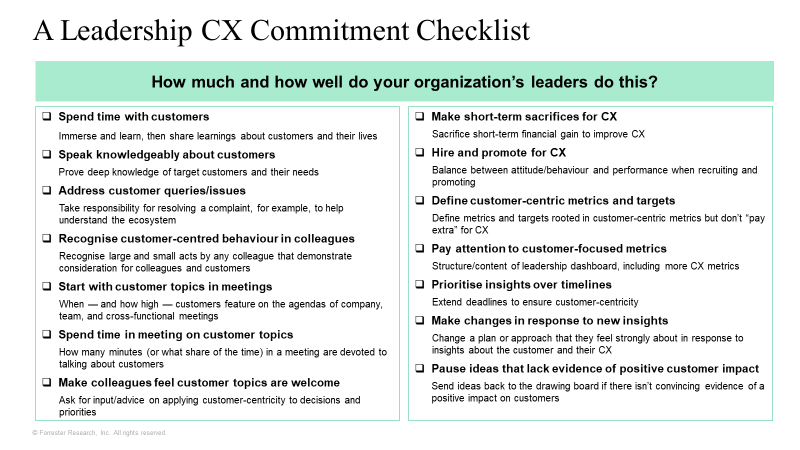CX Commitment Checklist: Help Your Executives Face Reality
Amidst a flurry of C-level leaders declaring that their organizations are currently or are becoming customer centric, customer experience (CX) leaders face their biggest battle yet: Making executives in their organization aware of the damaging shadow they as leaders cast on efforts to become more customer obsessed.
My colleague Richard Sheahan and I often talk to CX leaders who are stumped by the hurdles they face in the organization … some of them even despite a generous CX budget. We suggest that this is a consequence of the shadow that executives in the organization cast. And we observe that those executives and sometimes even CX leaders aren’t aware of that shadow. In this blog, we’ll share why we say this. And at the end of the blog you’ll find a tool that Richard first used with clients, which we then developed further and also tested with some CX professionals: A Leadership CX Commitment Checklist that can help you make that shadow visible.
The Reality: Most Organizations Are Not Customer Obsessed
When we look at our data, we see that companies are not customer led:
- Most companies are not customer obsessed. In the US, only 3% of business, IT, and marketing executives are from organizations that qualify as fully customer obsessed, according to Forrester’s State Of Customer Obsession Survey, 2022. The comparable number for EMEA is 2%.
- Customers’ experiences are not excellent. No single brand included in Forrester’s Customer Experience Benchmark Survey, 2022, fielded in the US and EMEA, received an excellent Customer Experience Index (CX Index™) score in 2022.
The Challenge: Executives Cast A Damaging Shadow, But Many Aren’t Aware
Many leaders seem to believe their love for customers. But their behaviors show they haven’t made customer obsession a part of their identity. They:
- Focus on short-term revenue gains at the expense of long-term customer loyalty.
- Hire and promote based on business KPIs, not customer-focused KPIs.
- Prioritize deadlines over ensuring customer insights are embedded in decision-making.
The Added Challenge: CX Professionals Aren’t Seeing This Shadow Clearly, Either
What’s worse is that many CX leaders don’t seem to believe this shadow exists:
- They expect their budgets to grow.
- 71% of European CX leaders report that their executive teams are not just committed to CX but act accordingly (see Forrester’s Q1 2022 Global State Of Customer Experience Programs Survey).
Make The Shadow Visible: Use Our Leadership CX Commitment Checklist
The dissonance between what leaders think and how they behave is a huge challenge for CX professionals. CX leaders must bridge this gap. How? Confront very senior stakeholders in their organizations, get them to acknowledge that dissonance, and help them understand the shadow they cast. The goal: Get leaders to develop identity-based CX habits.
Our checklist helps. CX leaders should ask leaders’ direct reports to fill in the Leadership CX Commitment Checklist. Then, have a frank discussion about what needs changing.

If you want to discuss more, please contact us. And if you want to read more about this topic, check out some of our research on future fit leaders.
